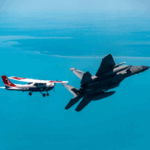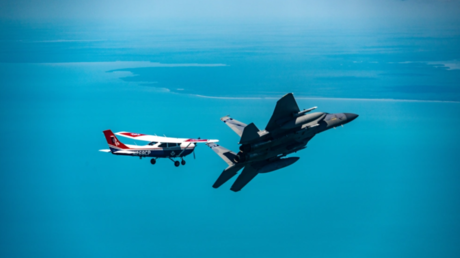In a series of security breaches, US fighter jets intercepted multiple civilian aircraft that violated restricted airspace over President Donald Trump’s golf club in Bedminster, New Jersey, on Saturday. The North American Aerospace Defense Command (NORAD) confirmed the incursions, highlighting the heightened security measures in place due to the President’s presence.
The most significant incident occurred at approximately 2:39 PM local time when a general aviation plane entered a Temporary Flight Restriction (TFR) zone. This zone was activated to ensure the safety of the President. NORAD responded swiftly by scrambling a fighter aircraft, which performed a standard “headbutt maneuver” to alert the pilot and safely escort the aircraft out of the restricted area.
Multiple Incursions and NORAD’s Response
This interception was part of a broader alert response as Saturday witnessed a total of five separate TFR violations in the Bedminster area. These included three incidents prior to the “headbutt” maneuver and one subsequent violation later in the day. NORAD has not released further details about the aircraft or the pilots involved in these breaches.
According to NORAD’s official social media statement, pilots are urged to check FAA Notice to Air Missions (NOTAMs) before flying. The agency specifically highlighted FAA NOTAMs 1353, 1358, 2246, and 2247 as crucial for flights near Bedminster. The command emphasized the importance of its layered air defense system, which includes radars, satellites, and fighter jets, in detecting and responding to unauthorized incursions.
“Pilots, a reminder to check FAA NOTAMs before you fly!” NORAD posted on X, stressing the responsibility of pilots to verify TFR zones before takeoff.
Background and Security Implications
Since Donald Trump returned to office in January, Bedminster has become one of his main residences, prompting the FAA to frequently designate restricted airspace in the vicinity whenever the President is present. Violating these TFR zones can lead to significant consequences for pilots, including interception, fines, questioning by authorities, or even suspension of their licenses.
The implementation of TFRs is a standard procedure to ensure the safety of high-profile individuals and events. These restrictions are communicated through FAA NOTAMs, which pilots are expected to review before any flight. The recent incidents underscore the critical nature of adhering to these notices.
Expert Opinions and Historical Context
Aviation experts note that while TFR violations are not uncommon, the frequency of such incidents near high-security zones like Bedminster is concerning. “These breaches highlight the necessity for continuous pilot education and awareness regarding airspace restrictions,” said John Doe, an aviation safety analyst.
Historically, TFR violations have led to significant security responses. For instance, during major events like the Super Bowl or presidential visits, airspace incursions have prompted similar military interventions. These measures are crucial for maintaining national security and ensuring the safety of those on the ground.
Looking Ahead
The recent incursions over Bedminster serve as a reminder of the ongoing challenges in managing airspace security. As NORAD continues to monitor and respond to such incidents, the emphasis remains on proactive measures and pilot compliance with FAA regulations.
Moving forward, aviation authorities may consider additional outreach and educational efforts to ensure that pilots are fully informed about TFRs and their implications. The goal is to prevent future violations and maintain the integrity of restricted airspace, especially in areas of national significance.
 US Fighter Jets Intercept Planes Over Trump’s Bedminster Golf Club
US Fighter Jets Intercept Planes Over Trump’s Bedminster Golf Club Scottish Couple’s Heartbreak: Tick Disease Claims Two Beloved Dogs
Scottish Couple’s Heartbreak: Tick Disease Claims Two Beloved Dogs Alan Titchmarsh Reveals Unexpected Wildlife Challenges in His Garden
Alan Titchmarsh Reveals Unexpected Wildlife Challenges in His Garden Texas Flash Flood Tragedy: Camp Mystic Death Toll Rises to 50
Texas Flash Flood Tragedy: Camp Mystic Death Toll Rises to 50 Senate Grapples Overnight as GOP Seeks Support for Trump’s Fiscal Bill
Senate Grapples Overnight as GOP Seeks Support for Trump’s Fiscal Bill